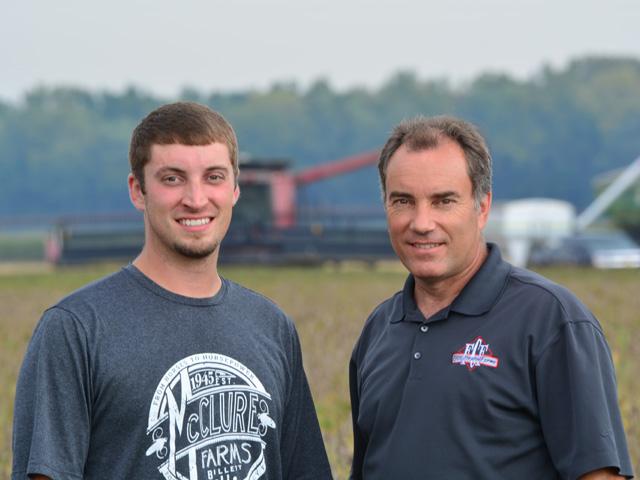Manage Soybeans to Push Profits
Illinois Farmers Outline Soybean Management Strategies
DECATUR, Ill. (DTN) -- Taking soybean production to the next level requires a different thought process. DTN asked Greg McClure and his son, Cameron, who farm near St. Francisville, Illinois, to outline some of the changes they've made during the past few years.
The father-son duo has been participating in AgriGold's Yield Masters program to explore opportunities and barriers to increasing soybean efficiency. Here's a snapshot of their soybean-management journey.
Q: What's been your crop rotation, and is that changing?
A: Until 2017, we continually planted 60% of our acres to corn with some fields having corn for 10 or more consecutive years. From 2017 through 2020, we tried to operate on a 50-50 ratio while rotating every acre between corn and beans annually. As demand has increased back toward soybean meal in many livestock diets and future demand for soybean oil to be used in biofuels, we decided in 2021 to pursue several acres of high-management bean-on-bean production. Interestingly, we harvested the highest single bean yield ever seen on our farm on those very acres by focusing on those aspects we were afraid would hinder yields. We are carefully monitoring the practice with an eye on long-term trade-offs.
Q: What are a few things that you've worked on regarding soybean management? What has been your biggest surprise?
A: 1. Early planting. We see nearly a half-bushel-per-day yield drag for every day we delay planting past the ground being ready. We start the process in the fall with ground and equipment preparation to increase our odds of planting as early as possible. Extremely early planting into cold ground temperatures may reduce plant populations, but we still see added yield. There is a time element and hormone balance that we believe affects the plant structure in a way that promotes increased reproduction.
2. Plant protection. We apply fungicides and insecticide to every acre of soybeans. In our high-humidity, low-sunlight region, we see yield increases by preserving the leaf integrity for photosynthesis and sugar production.
P[L1] D[0x0] M[300x250] OOP[F] ADUNIT[] T[]
3. Plant structure. We firmly believe the larger the stem diameter, the greater the genetic potential of the plant. We focus on the first 30 to 60 days of the plant's life to increase cytokinin production by building the correct root structure, using the right nutrients that create vegetative growth, while minimizing internode lengths and applying the nutrients that are necessary to increase reproductive energy to be stored in the plant. Our goal is to build a robust plant structure through balanced nutrition that can store enough reproductive energy to support a heavy seed load.
Our biggest surprise has been using a variety with a propensity for lateral proliferation. We continue to be amazed by the fact that we see very little yield difference in all planting populations between 30,000 and 110,000.
Q: Can the soybean be managed mid-to-late season?
A: Since today's seed treatments allow us to plant as early as the ground permits with little fear of sudden death syndrome (SDS), we continually see our beans flowering in late May and pod set either beginning or in full swing by the summer solstice. With harvest not happening until September at the earliest, we often find in early planted fields with high yield potential that we are filling pods for nearly two months and therefore, a second application of fungicide often returns a nice return on our investment.
Q: Do you see ways to manage moisture in late August/early September to increase seed fill?
A: Managing moisture during grain fill starts up front with building the correct plant structure. We must ensure we have adequate root growth; manage the vegetative growth characteristics focusing on larger stem diameter and shorter internodes; protect plant health; and make sure our plants have the right mineral balance to use water efficiently during photosynthesis and respiration. Building a healthy soil with the right nutrient ratios and properly timed and correct placements of additional applications of nutrients, as well as stress mitigation products, allow us to use water more efficiently within the plant, thus decreasing the amount of water needed to reach our yield goals. Focusing on increasing calcium and manganese uptake early as well as raising potassium levels within the plant during reproduction phases are a couple of management keys to managing water efficiency and reducing water consumption.
Q: Is management all about yield?
A: Management is about maximizing ROI (return on investment) per acre. While we do several acres of trials annually, we realize we will fail more often than we succeed while attempting to prove new concepts or products. We will not slow down on trials, since this is where innovation and advancement occur. We know we have to manage our financial risk with unproven practices on a large number of acres. Those that are proven to have a positive ROI are moved to more acres across the operation.
Q: What is the biggest thing you've learned about managing soybeans?
A: The biggest thing I've learned the past five years about managing soybeans is exactly that: Manage them. Prior to 2017, we did very little to manage our soybeans. Today, we believe as an industry, we still know more about capturing genetic potential of corn than soybeans. That thought fueled us to go all in on soybean research and trials believing that we would find increasing our bean yields might happen quickly. While several management practices are the same between corn and soybeans, with examples being seed spacing, even emergence, pest and disease protection all driving yield, we are also discovering there are plenty of management practices which need to be different. The more we study plant hormones, C3 versus C4 plants and monocot versus dicot plants, we begin to understand some of the mistakes of our past which has robbed yield from us and what we should do differently to capture as much genetic potential as possible.
**
Editor's Note: See related story, "Manage Soybeans All Season Long" at https://www.dtnpf.com/….
Pamela Smith can be reached at pamela.smith@dtn.com
Follow her on Twitter @PamSmithDTN
(c) Copyright 2022 DTN, LLC. All rights reserved.





